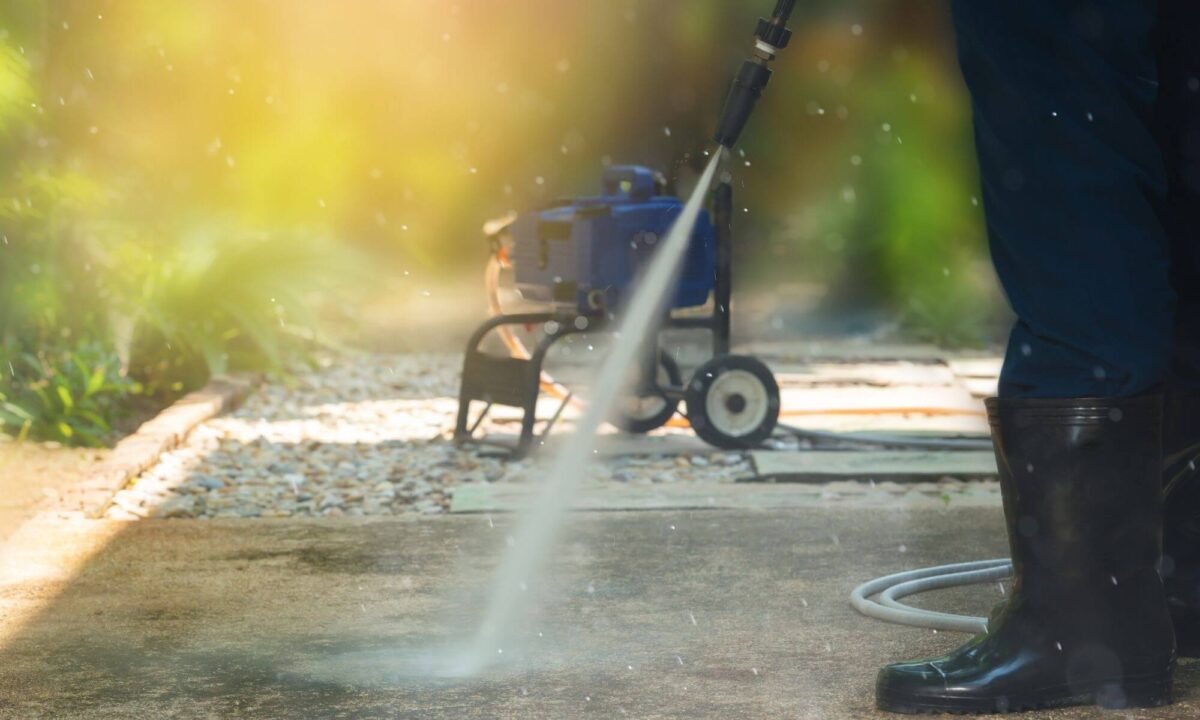Keeping a home’s exterior clean isn’t just about looks—it’s about protecting your investment. Residential pressure washing removes dirt, mold, mildew, and grime that can damage siding, driveways, and decks. With the right techniques, you can boost curb appeal, protect surfaces, and even improve air quality around your home.
In this guide, we’ll explore house exterior cleaning techniques, the benefits of residential power washing, safety tips, the best time to schedule the job, and eco-friendly cleaning solutions.
Understanding Residential Pressure Washing
Residential pressure washing uses a high-powered stream of water to clean exterior surfaces. It can be used on siding, patios, driveways, fences, and decks. While “pressure washing” and “power washing” are often used interchangeably, there’s a subtle difference:
- Pressure washing uses normal-temperature water with high pressure.
- Power washing uses heated water, which is better for removing grease and stubborn stains.
Another related method is soft washing, which uses low pressure and specialized cleaning solutions—perfect for delicate materials like wood siding or asphalt shingles.
House Exterior Cleaning Techniques
Soft Washing vs High-Pressure Washing
- Soft washing uses gentle water pressure with biodegradable cleaners to remove mold, mildew, and dirt without damaging the surface. This is ideal for roofs, painted siding, and older homes.
- High-pressure washing is better for concrete driveways, brick walls, and metal fences where a stronger stream is needed to break up grime.
For Details Read this: Soft Washing vs High-Pressure Washing
Step-by-Step House Exterior Cleaning Process
- Pre-inspection – Check for cracks, peeling paint, and damaged areas before starting.
- Select the right nozzle and PSI – A 25° nozzle is great for general cleaning; 0° should be avoided for siding as it can damage it.
- Apply detergent – Use a cleaning solution suitable for your surface type, letting it sit for 5–10 minutes.
-
Rinse thoroughly – Work from top to bottom for an even clean.
Common Mistakes to Avoid
- Using too much pressure on vinyl siding, which can cause cracks.
- Spraying at an upward angle, which can force water behind siding and cause mold.
- Skipping detergent, leading to shorter-lasting results.
Benefits of Residential Power Washing
Residential power washing isn’t just about a pretty home. It delivers practical advantages:
- Restores curb appeal – Your home looks newer and more inviting.
- Prevents damage – Removes harmful growth like mold and algae that can degrade materials.
- Extends surface lifespan – Reduces the need for repainting or resurfacing.
- Boosts property value – A clean exterior can increase perceived value by thousands.
- Improves health – Eliminates allergens, pollen, and pollutants.
Pressure Washing Safety Tips
Even though it’s effective, pressure washing can be dangerous without proper precautions.
Personal Protective Equipment (PPE)
- Wear safety goggles to protect eyes from flying debris.
- Use gloves for grip and protection.
- Wear non-slip boots to prevent falls.
Equipment Handling Precautions
- Keep the nozzle at least 12 inches from the surface.
- Never spray electrical outlets or wiring.
- Be cautious with ladders—high pressure can cause loss of balance.
Protecting Plants and Landscaping
- Cover plants with breathable tarps.
- Use plant-safe cleaning solutions.
- Rinse surrounding areas with water before and after washing.
Best Time to Pressure Wash a House
In most climates, the ideal time to pressure wash is spring or fall.
- Spring – Remove winter dirt, salt, and mold.
- Fall – Prepare surfaces for winter, reducing the chance of mildew growth.
Avoid extreme temperatures—hot days can cause detergents to dry too quickly, while freezing weather can damage equipment and surfaces. Schedule pressure washing before painting or sealing to ensure better adhesion.
Eco-Friendly Pressure Washing Solutions
Pressure washing doesn’t have to harm the environment.
Biodegradable Detergents
Choose cleaning products that break down naturally and are safe for plants and pets.
Water Conservation Practices
Use low-flow nozzles and reclaim systems to reduce water waste.
Alternatives to Harsh Chemicals
- Vinegar for mold and mildew
- Baking soda for gentle scrubbing
- Citrus-based cleaners for grease and oil stains
Hiring a Professional vs DIY
DIY Pressure Washing
Pros: Lower cost, full control over cleaning.
Cons: Risk of damage, requires equipment rental or purchase, time-consuming.
Professional Pressure Washing
Pros: Expertise, proper equipment, faster results, insured work.
Cons: Higher upfront cost.
Tip: When hiring, ask about their cleaning process, detergents used, insurance coverage, and experience with your home’s materials.
Maintenance Schedule for a Clean Home Exterior
A general rule is to pressure wash your home once a year. However, if you live in a humid or dusty area, you may need it every 6 months.
Signs you need another wash:
- Visible mold or mildew
- Faded siding color
- Slippery surfaces on decks or patios
Combine pressure washing with gutter cleaning and window washing for a complete exterior refresh.
Final Note
A well-maintained exterior is more than just visual appeal—it’s a form of preventive maintenance. By following the right house exterior cleaning techniques, applying pressure washing safety tips, using eco-friendly pressure washing solutions, and cleaning at the best time of year, you can keep your home looking great for years while protecting its value.


